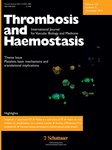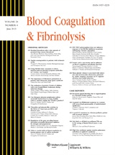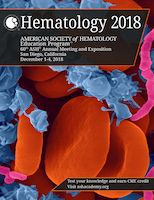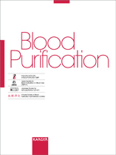
THROMBOSIS AND HAEMOSTASIS
Scope & Guideline
Transforming Understanding of Hematological Disorders
Introduction
Aims and Scopes
- Thrombosis and Hemostasis Mechanisms:
The journal emphasizes research on the underlying biological mechanisms of thrombosis and hemostasis, exploring the molecular, cellular, and genetic factors that contribute to these processes. - Clinical Outcomes and Management Strategies:
A significant focus is placed on clinical studies that assess the effectiveness of various anticoagulant therapies, management strategies for patients with thrombotic disorders, and the implications of these treatments on patient outcomes. - Innovative Therapeutic Approaches:
The journal highlights studies that explore novel therapeutic approaches for managing thrombotic and bleeding disorders, including the development of new anticoagulants and antiplatelet agents. - Risk Assessment and Predictive Modeling:
Research on risk factors and predictive models for thrombotic events is a key area of interest, aiming to improve risk stratification and patient management. - Translational Research:
The journal publishes findings that bridge basic science and clinical practice, facilitating the translation of laboratory discoveries into therapeutic applications for patients with thrombotic disorders.
Trending and Emerging
- COVID-19 and Thrombosis:
A significant increase in research focusing on the relationship between COVID-19 and thrombotic events highlights the pandemic's impact on thrombosis research, emphasizing the need for understanding coagulopathy in infected patients. - Personalized Medicine in Anticoagulation:
Emerging studies emphasize the importance of personalized approaches to anticoagulation therapy, including tailoring treatments based on genetic, phenotypic, and clinical characteristics of patients. - Machine Learning and Predictive Analytics:
The integration of machine learning techniques for predicting thrombotic events and optimizing treatment strategies is gaining traction, reflecting a broader trend towards data-driven decision-making in healthcare. - Cancer-Associated Thrombosis:
Research specifically addressing the complexities of thrombosis in cancer patients is increasingly prevalent, focusing on the unique risk factors and management strategies required for this population. - Innovative Biomarkers:
There is a growing emphasis on identifying and validating novel biomarkers for predicting thrombosis and bleeding risks, which may enhance risk stratification and personalized treatment approaches.
Declining or Waning
- Traditional Anticoagulant Therapies:
There is a noticeable reduction in studies focused solely on traditional anticoagulant therapies such as warfarin, as newer agents like direct oral anticoagulants (DOACs) gain prominence in research. - Basic Science of Hemostasis:
Research that solely focuses on the basic science of hemostasis without practical clinical applications appears to be less frequent, as the journal shifts towards more clinically relevant studies. - Static Risk Factor Studies:
Studies that merely catalog risk factors without integrating them into predictive models or clinical applications are becoming less common, reflecting a trend towards more dynamic and actionable research. - Single-Center Studies:
There appears to be a decline in the publication of single-center studies as multi-center and larger cohort studies become the norm, likely due to the increased need for robust data in diverse populations. - Pharmacokinetics of Established Drugs:
Research focusing on the pharmacokinetics of well-established anticoagulants without new insights or comparative analyses is becoming less frequent, as emphasis shifts to novel agents and their clinical implications.
Similar Journals

Journal of Hematology
Connecting Scholars, Enhancing PracticeThe Journal of Hematology, published by ELMER PRESS INC, serves as a pivotal platform for disseminating cutting-edge research in the field of hematology. With an ISSN of 1927-1212 and an E-ISSN of 1927-1220, this journal is committed to advancing scientific knowledge and clinical practice through high-quality peer-reviewed articles encompassing all aspects of blood disorders, from basic science to health policy implications. While the journal currently operates under a traditional access model, it nonetheless prioritizes the rapid publication of significant findings, ensuring that researchers, clinicians, and students have timely access to the latest advancements in hematological research. Positioned to bridge gaps in knowledge and foster collaboration among scholars worldwide, the Journal of Hematology is an essential resource for anyone invested in this vital area of medicine.

SEMINARS IN THROMBOSIS AND HEMOSTASIS
Advancing knowledge in thrombosis and hemostasis.SEMINARS IN THROMBOSIS AND HEMOSTASIS is a prestigious academic journal dedicated to advancing the understanding and practice of thrombosis and hemostasis, published by THIEME MEDICAL PUBL INC. With an ISSN of 0094-6176 and an E-ISSN of 1098-9064, this journal plays a critical role in disseminating groundbreaking research and reviews in the fields of cardiology and hematology. As of 2023, it holds a commendable Q2 ranking in both the Cardiology and Cardiovascular Medicine and Hematology categories, with Scopus ranks of #55 out of 387 and #23 out of 137, respectively, positioning it within the top percentiles of these disciplines. The journal publishes articles that bring forth innovative findings and facilitate clinical applications, making it an essential resource for researchers, healthcare professionals, and students focused on improving patient care and outcomes. Since its inception in 1974, SEMINARS IN THROMBOSIS AND HEMOSTASIS continues to evolve with the changing landscape of medical research, striving to fill the gaps in knowledge and foster an informed approach to hemostatic disorders.

Blood and Lymphatic Cancer-Targets and Therapy
Advancing Knowledge in Hematology and OncologyBlood and Lymphatic Cancer-Targets and Therapy, published by DOVE MEDICAL PRESS LTD, is a vital open-access journal that has been disseminating crucial research and findings in the field of hematology and oncology since 2011. With its ISSN 1179-9889, this journal focuses on the latest therapeutic targets and innovative treatment strategies for blood and lymphatic cancers, contributing significantly to the advancement of knowledge and practice in this specialized area. Designed for researchers, healthcare professionals, and students alike, Blood and Lymphatic Cancer-Targets and Therapy aims to foster a deeper understanding of cancer biology and promote collaborative efforts leading to novel therapeutic interventions. The open-access model ensures that research findings are readily accessible to a global audience, underscoring the journal's commitment to enhancing patient care and fostering educational growth in the cancer domain.

JOURNAL OF THROMBOSIS AND THROMBOLYSIS
Elevating discourse in cardiovascular medicine.JOURNAL OF THROMBOSIS AND THROMBOLYSIS, published by Springer in the Netherlands, serves as a vital platform for research in the fields of Cardiology and Cardiovascular Medicine and Hematology. With an impressive impact factor, this journal ranks in the Q2 category for both fields according to the latest metrics, evidencing its significant influence and contribution to ongoing scholarly discourse. Spanning over three decades from 1994 to 2024, the journal provides an essential source for innovative studies, clinical practices, and comprehensive reviews related to thrombosis and thrombolysis. Researchers, clinicians, and students alike will find valuable insights and cutting-edge knowledge that address the complexities of blood coagulation and its implications in cardiovascular health. The journal is indexed in Scopus, with commendable rankings, further establishing its reputation in the academic community.

BLOOD COAGULATION & FIBRINOLYSIS
Bridging Molecular Insights and Clinical ApplicationsBLOOD COAGULATION & FIBRINOLYSIS, a distinguished journal in the field of hematology, is published by Lippincott Williams & Wilkins, a reputable name in academic publishing. Since its inception in 1990, this journal has been committed to advancing the understanding of blood coagulation and fibrinolysis, focusing on the molecular mechanisms, clinical implications, and therapeutic aspects of these critical processes. With an impact factor reflecting its significance within the academic community, currently ranking Q3 in both Hematology and Miscellaneous Medicine for 2023, this journal serves as a pivotal platform for researchers and professionals alike. By providing access to cutting-edge research and reviews, BLOOD COAGULATION & FIBRINOLYSIS endeavors to foster collaboration and innovation in the treatment of coagulation disorders. Interested readers can explore ongoing contributions to the field through subscriptions and institutional access options.

Hematology-American Society of Hematology Education Program
Bridging Research and Practice in HematologyHematology-American Society of Hematology Education Program is a premier peer-reviewed journal dedicated to advancing the field of hematology through comprehensive educational content. Published by the American Society of Hematology, this journal plays a crucial role in disseminating knowledge to researchers, clinicians, and students in hematology and related disciplines. With an impressive Q1 status in the field, it ranks among the top journals at the forefront of hematological research, as evidenced by its 60th percentile ranking in Scopus' Medicine - Hematology category. Although it does not offer open access, the journal provides invaluable insights and educational resources from leading experts, focusing on the latest advancements, treatment protocols, and evolving understanding of blood disorders. Covering a wide range of topics, from basic research to clinical applications, this journal is essential for anyone seeking to deepen their expertise and stay informed on the latest developments in hematology. For further engagement, readers can access insightful articles published since 2001, ensuring a rich repository of knowledge for ongoing research and clinical excellence.

Journal of Blood Medicine
Connecting Minds: Bridging Research and Clinical Practice in HematologyThe Journal of Blood Medicine, published by DOVE MEDICAL PRESS LTD, stands as a vital resource in the field of hematology, focusing on the latest research developments and clinical advancements in blood medicine. With an impact factor reflective of its growing relevance, this open-access journal has been delivering quality scholarly work since 2010, ensuring that critical research is readily available to the global scientific community. The journal operates under an open-access model, further enhancing its dissemination and accessibility to researchers, professionals, and students alike. In the 2023 rankings, it secured a Q3 category status within hematology and achieved a commendable 76th rank out of 137 in Scopus listings, indicating its commitment to quality and innovation in this specialized area. Located in New Zealand, the journal's diverse topics encompass clinical research, treatment modalities, and emerging therapies, contributing significant insights vital for shaping future advancements in blood medicine.

Research and Practice in Thrombosis and Haemostasis
Elevating clinical practice through shared research.Research and Practice in Thrombosis and Haemostasis, published by Elsevier, is a prominent open-access journal dedicated to advancing the field of hematology through high-quality research and clinical practice. Since its inception in 2017, this journal has established itself as a vital resource for researchers, healthcare professionals, and students interested in thrombosis and hemorrhage management, showcasing original research, reviews, and clinical studies. The journal’s commitment to accessible knowledge is reflected in its open-access model, allowing researchers worldwide to share their findings without financial barriers. With an impressive 2023 Scopus rank of #42 out of 137 in the hematology category and a respectable Q2 classification, it provides an authoritative platform for innovative ideas and cutting-edge developments in the field. As the journal continues to grow in stature, it aims to foster collaboration and knowledge exchange amongst professionals dedicated to improving patient outcomes in thrombosis and hemostasis.

THROMBOSIS RESEARCH
Exploring Breakthroughs in Thrombosis and HemostasisTHROMBOSIS RESEARCH is a leading peer-reviewed journal in the field of hematology, published by PERGAMON-ELSEVIER SCIENCE LTD. With an impressive impact factor and ranked within the top 10 of 137 in its category according to Scopus, this journal provides a critical platform for the dissemination of innovative research related to thrombosis and hemostasis. Established in 1972, THROMBOSIS RESEARCH has been at the forefront of scholarly communication, addressing key issues, findings, and advancements over more than five decades. Recognized for its high-quality content, the journal is categorized in the Q1 quartile for 2023, reflecting its influence and relevance within the scientific community. Researchers, medical professionals, and students engaged in the study of blood disorders will find valuable insights and the latest discoveries within its pages. Although currently not an open-access publication, THROMBOSIS RESEARCH remains accessible to a wide audience through institutional subscriptions, ensuring that vital research continues to inform and enhance clinical practices around the globe.

BLOOD PURIFICATION
Connecting Scholars to Transform Blood Health.BLOOD PURIFICATION is a distinguished peer-reviewed journal published by KARGER, recognized for its in-depth exploration of the interdisciplinary topics surrounding blood purification technologies and techniques, encompassing nephrology and hematology. Since its inception in 1983, this reputable journal has provided a vital platform for disseminating groundbreaking research, reviews, and clinical practices aimed at advancing the understanding and management of blood-related conditions. With an impressive impact factor positioned within the second quartile (Q2) in the fields of Hematology, Nephrology, and Miscellaneous Medicine (2023), BLOOD PURIFICATION is highly regarded among researchers and professionals dedicated to enhancing patient outcomes. The journal aims to foster a collaborative academic environment, sharing innovative findings and methodologies, making it an essential resource for scholars, clinicians, and students alike. This publication does not currently offer Open Access options, and is based in Switzerland, with its editorial office located at Allschwilerstrasse 10, CH-4009 Basel. Engage with BLOOD PURIFICATION to stay at the forefront of advancements in blood purification science.